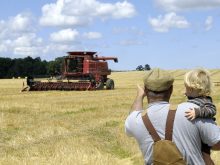Statistics keepers say the average middle-aged North American will inherit $100,000 in the next 20 years. Many will spend it on anything from the big trip they have dreamed of taking to a pair of chromed-up Harley bikes to adding a sunroom on the house.
When we were young, $100,000 was a lot of bread. In fact a person could probably retire on it. Now, if you want to make it count toward your retirement, it needs to be managed. There are two questions to consider:
- How much do you need to retire on?
Read Also

Crop profitability looks grim in new outlook
With grain prices depressed, returns per acre are looking dismal on all the major crops with some significantly worse than others.
If you aren’t tracking your expenses now, chances are good you won’t when you retire. So how do you figure out how much you’ll need?
Here’s a simple way. Let’s say you take $30,000 a year out of the farm or ranch account for family expenses such as food, cars, credit cards, savings and so forth. This means you need $30,000 a year to maintain your lifestyle. True, some expenses may go down, such as clothing if you now have a job off the ranch, but others, such as recreation, might go up. It works out about the same in the end. The basic rule of thumb is you need 70 to 100 percent of your working income to maintain your lifestyle in retirement.
If you do keep track of expenses, you’ll have a better idea of your spending habits and probably will already have cut out impulse spending, but the 70 to 100 percent rule still applies.
As well, don’t forget to index that $30,000 to the inflation rate; $30,000 today may be $40,000 in 10 years.
- How can you manage your $100,000 to make sure you have the retirement money you need?
Your banker or accountant might suggest you reduce debt by paying down the mortgage on your ranch. That might be a good idea. Let’s assume an average amortization left on the ranch mortgage of 15 years, at about six percent (you took out the mortgage before the current low rates came along).
So, $100,000 amortized over 15 years at six percent is $151,178.40. If you reduced your mortgage by $100,000, you would save $51,178.40 in interest costs and free up about $10,000 extra cash flow per year. If you didn’t use that extra cash for something else but kept making the same size mortgage payments, you could pay your ranch off faster. As you approached retirement, you would perhaps have no mortgage and be able to set aside more money every year.
Your financial adviser might suggest putting the money into mutual funds, pointing out that over the long term the market always outperforms interest rates.
The problem is, the market is unpredictable. Saying it outperforms interest rates in the long run is about as useful as saying that on average your feet are at a comfortable temperature if you have one of them in hot water and the other in cold.
If you were building your retirement nest egg through mutual funds during the 1990s, as I was, things looked pretty rosy. They didn’t look so great in the early years of this century.
Assuming you are older than 50, which is why you are reading this, putting your $100,000 into mutual funds is a tad risky. We had the longest bull market in history during the 1980s and 1990s, and then it started to look like we were into the longest bear market ever.
However, putting it into interest-bearing instruments isn’t going to help much at today’s interest rates.
So what’s a person to do?
Robert Kiyosaki, author of books such as Rich Dad, Poor Dad and The Cashflow Quadrant, suggests investing in businesses or real estate.
Being a rancher means you are already either self-employed or running a business and maybe you don’t want to invest in another one, so let’s look at real estate.
Say you take the $100,000 and buy four one-bedroom condos in a nearby city. Before you do this, you read several books on investing in real estate and you do a lot of looking to become familiar with what is on the market. You might look at 100 properties, make an offer on five and close on one.
You also read Not One Dollar More: How to Save $3,000 to $30,000 Buying Your Next Home, by Joseph ƒamon Cummins.
Now, let’s say you buy these condos for about $90,000 each. You put 25 percent down, pay about $1,000 in closing costs and allow $1,500 for pre-purchase inspections, repairs and redecorating, which brings your total investment to $25,000 per condo. You have $67,500 mortgages on each at five percent, which amortized over 25 years means monthly payments of $392.58 and we’ll assume a monthly condo fee, taxes and insurance payment of $177.42, resulting in a total monthly expenditure of $570.
You charge $695 per month rent on each, which leaves a monthly cash flow per condo of $125. Multiply that by four and you have about $500 per month net income. You build up a cash reserve to handle unexpected expenses and then begin making extra principal payments at the end of every year, which allows you to pay off the mortgages in 15 years, just in time to retire.
You now own four condos that are netting you about $2,900 per month, or $34,800 per year, allowing for three percent interest.
That’s more than the $51,000 you saved by paying down the ranch mortgage, but it means extra learning and risk, which might be a good thing. Kiyosaki says many men get depressed in their 50s because they have stopped taking risks.
Some say it takes $1 million in savings to retire comfortably on the interest these days. If you aren’t going to have that much, it might be an idea to start doing what I heard a Canadian comedian say: start eating cat food now.
Edmonton-based Noel McNaughton is a professional speaker, coach and writer who specializes in guiding men and women through the uncertainty of life transitions. He can be reached toll-free at 877-736-1552. Website: www.midlife-men.com.














